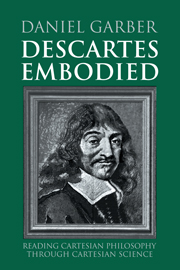Book contents
- Frontmatter
- Contents
- Acknowledgments
- Abbreviations, Citations, and Translations
- Introduction
- Part I Historiographical Preliminaries
- Part II Method, Order, and Certainty
- 2 Descartes and Method in 1637
- 3 A Point of Order: Analysis, Synthesis, and Descartes' Principles (with Lesley Cohen)
- 4 J.-B. Morin and the Second Objections
- 5 Descartes and Experiment in the Discourse and Essays
- 6 Descartes on Knowledge and Certainty: From the Discours to the Principia
- Part III Mind, Body, and the Laws of Nature
- Part IV Larger Visions
- Sources
- Index
3 - A Point of Order: Analysis, Synthesis, and Descartes' Principles (with Lesley Cohen)
Published online by Cambridge University Press: 10 November 2009
- Frontmatter
- Contents
- Acknowledgments
- Abbreviations, Citations, and Translations
- Introduction
- Part I Historiographical Preliminaries
- Part II Method, Order, and Certainty
- 2 Descartes and Method in 1637
- 3 A Point of Order: Analysis, Synthesis, and Descartes' Principles (with Lesley Cohen)
- 4 J.-B. Morin and the Second Objections
- 5 Descartes and Experiment in the Discourse and Essays
- 6 Descartes on Knowledge and Certainty: From the Discours to the Principia
- Part III Mind, Body, and the Laws of Nature
- Part IV Larger Visions
- Sources
- Index
Summary
The serious student of Descartes' philosophy must deal with the fact that Descartes' metaphysics is presented in a number of different ways in a number of different works. While the Meditations ought to be regarded as the authoritative text, it is important to account for the sometimes significantly different versions of the philosophy that Descartes presents in the Discourse, the Principles of Philosophy, the Search After Truth, and in numerous remarks scattered throughout the correspondence. In this essay we shall examine one attempt to explain the principal differences between two of these works: the Meditations and the Principles. It is often claimed that these differences can be explained by the fact that the Meditations are written in accordance with the analytic method, whereas the Principles are written in accordance with the synthetic method. We shall argue against two somewhat different versions of this thesis. Although we have no counter-thesis of comparable power or simplicity to offer, we shall suggest some ways of understanding the relations between these two central works that better reflect the texts and what appear to be Descartes' intentions.
The main source for our understanding of Descartes' distinction between analysis and synthesis is the difficult thought often cited passage at the end of the Second Replies (AT VII 155–156). In the Second Objections, Descartes is requested to present his argument in more geometrico, with the full apparatus of definitions, postulates, and axioms (AT VII, 128). Descartes complies with this request in the Geometrical Appendix which follows his Second Replies where he provides a geometrical exposition of some of his arguments. But first Descartes gives a general discussion of the geometrical method of presentation.
- Type
- Chapter
- Information
- Descartes EmbodiedReading Cartesian Philosophy through Cartesian Science, pp. 52 - 63Publisher: Cambridge University PressPrint publication year: 2000
- 2
- Cited by



